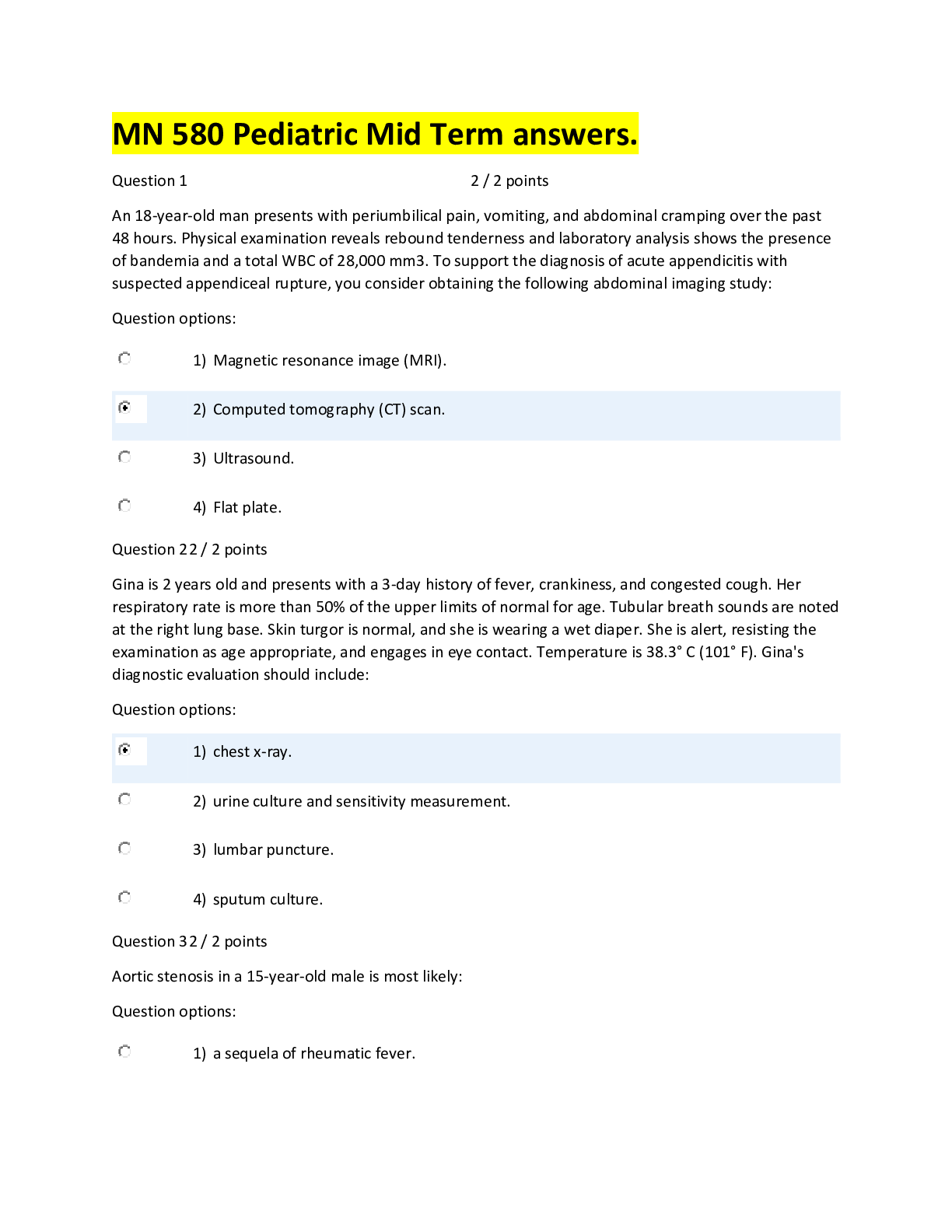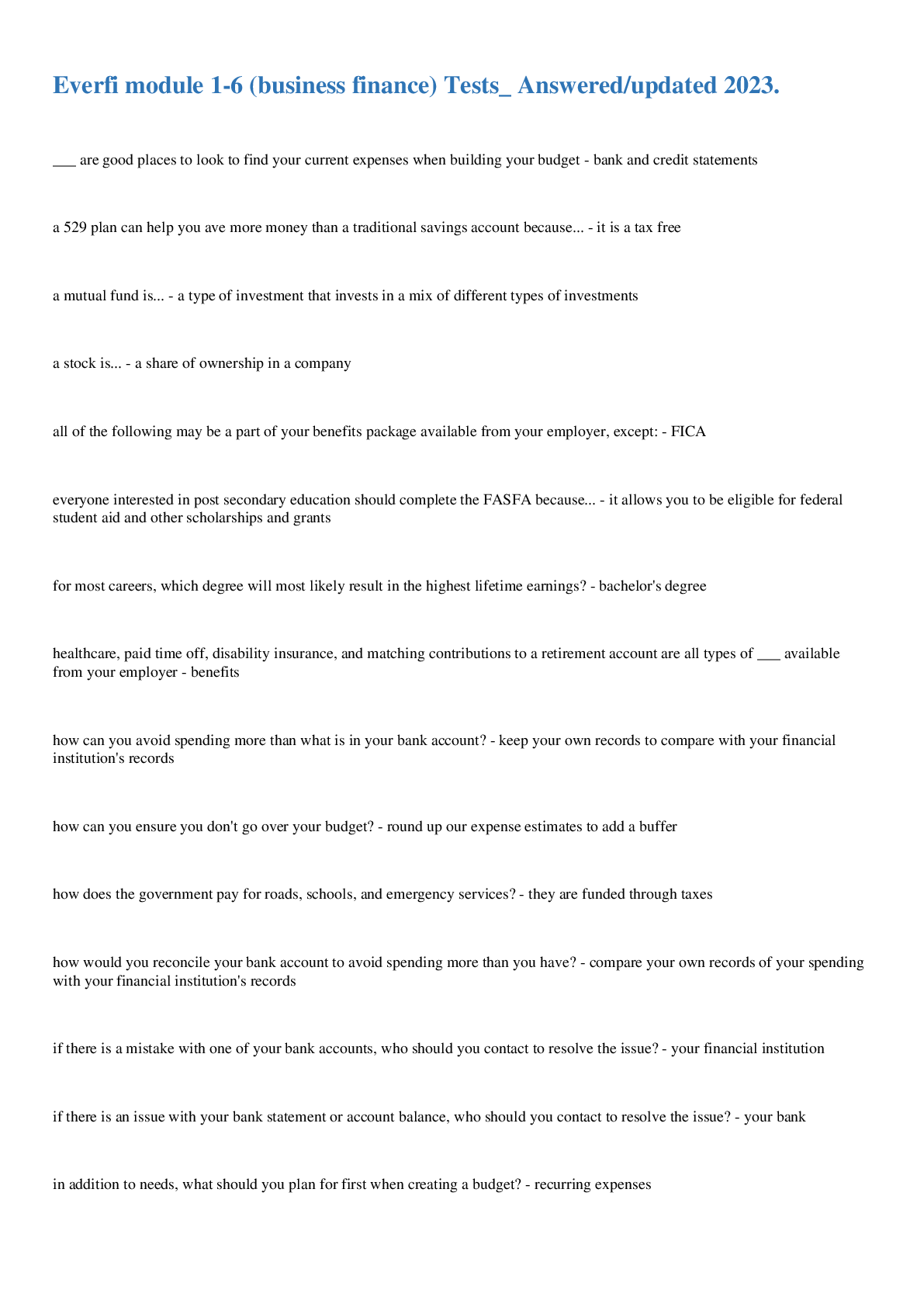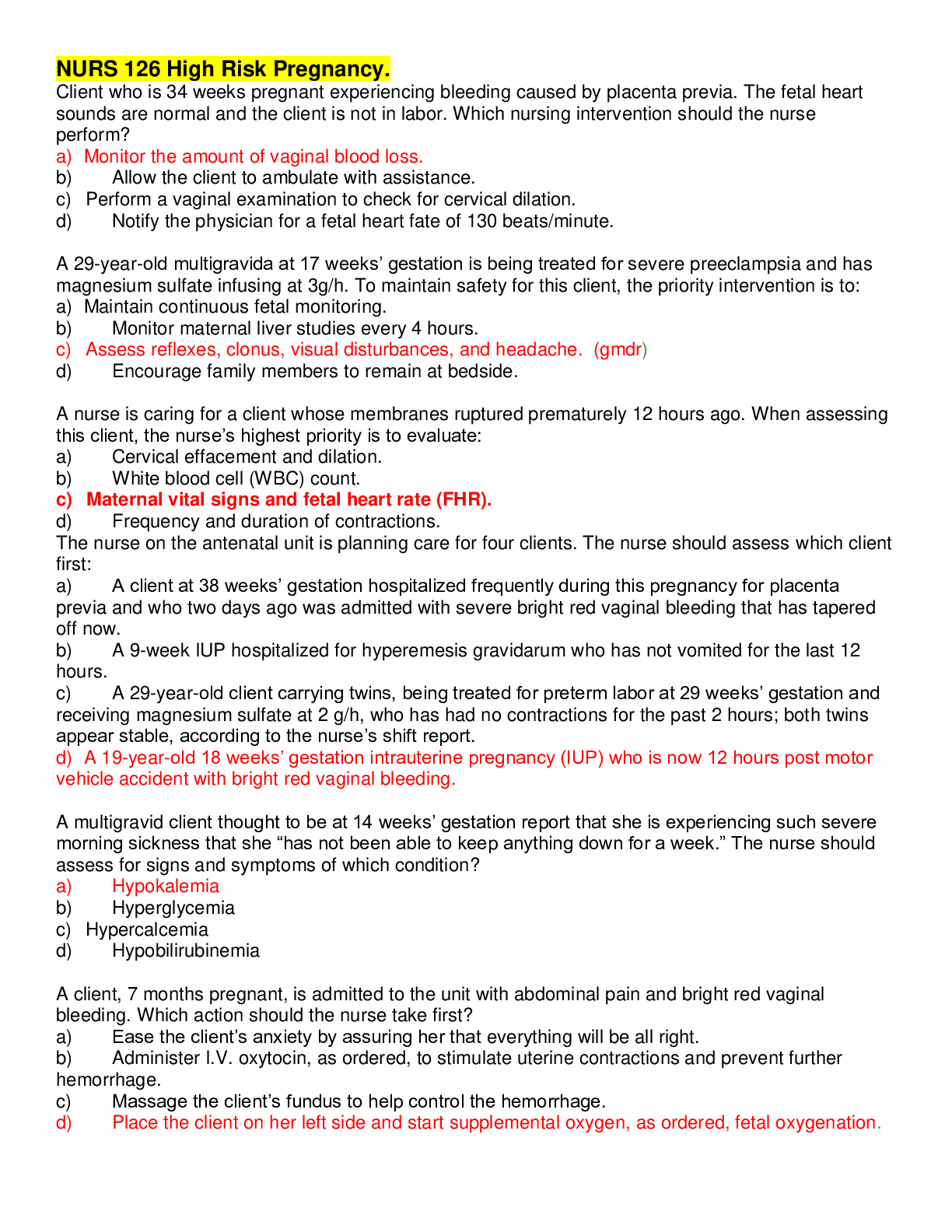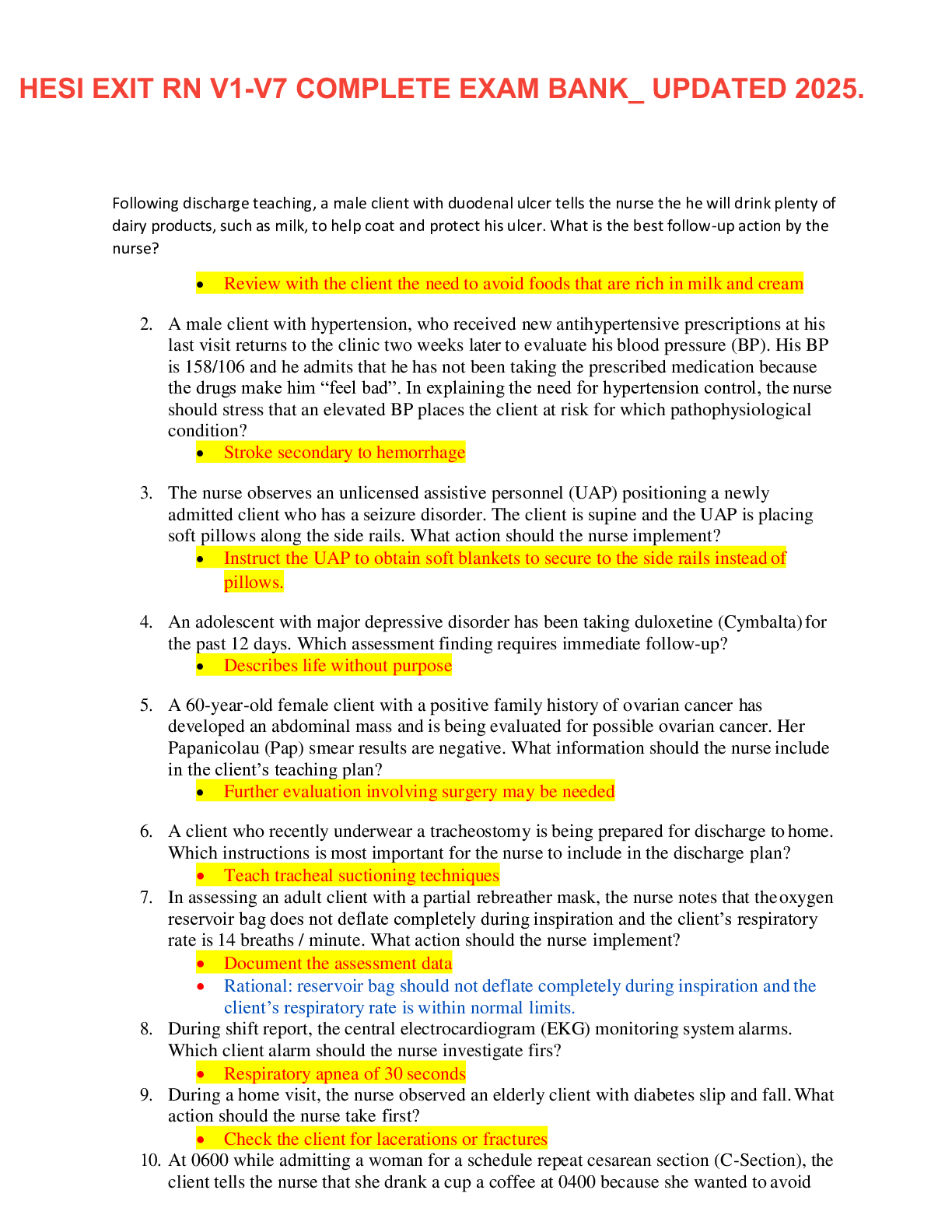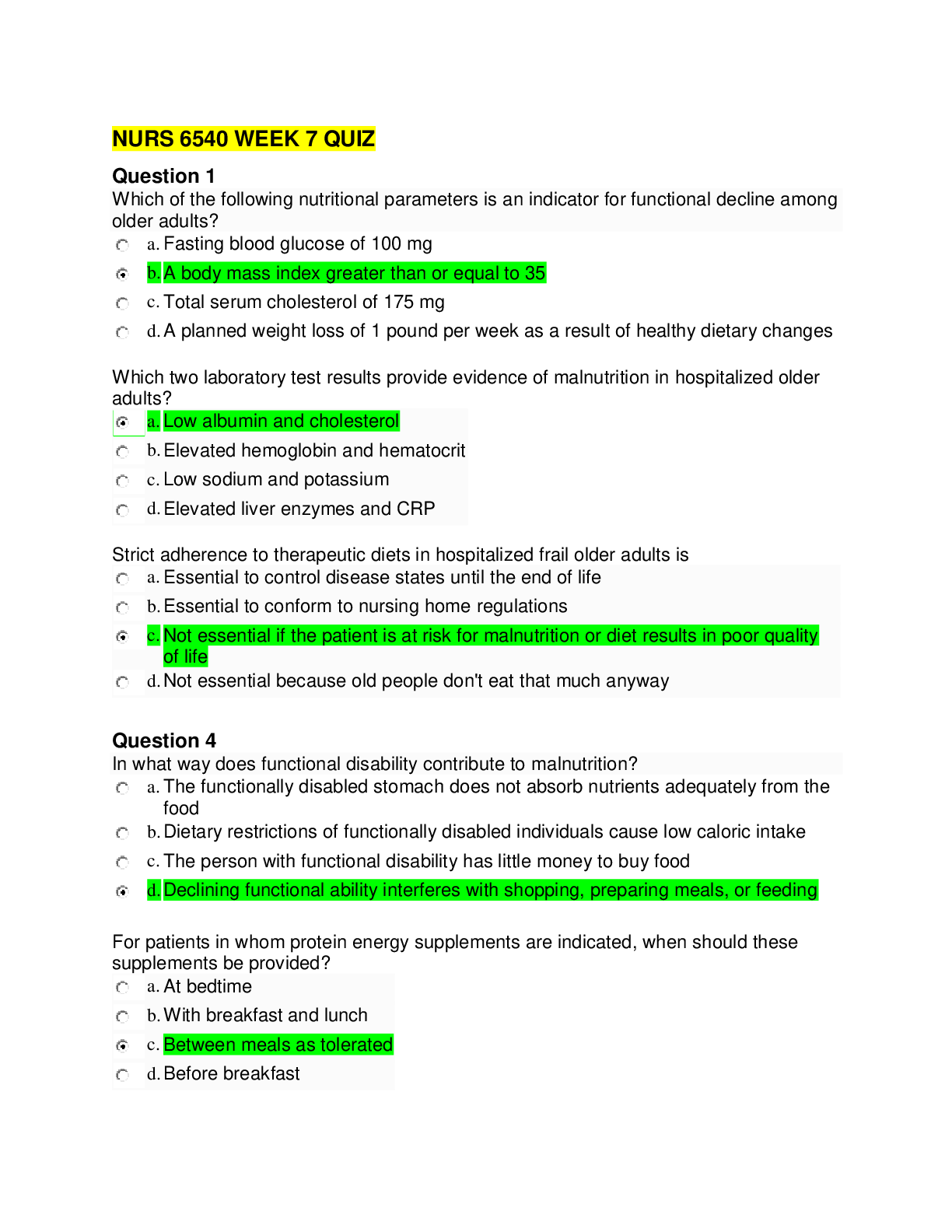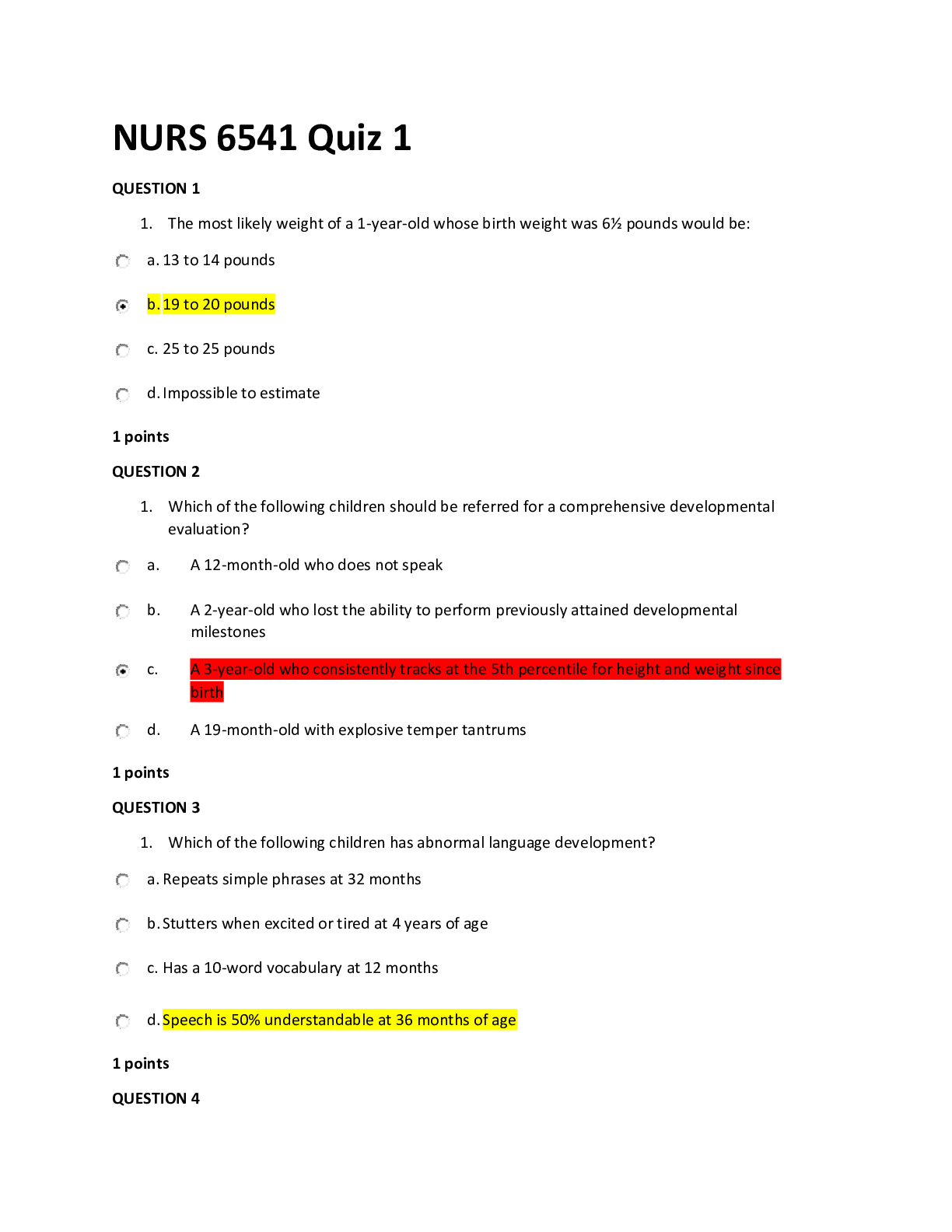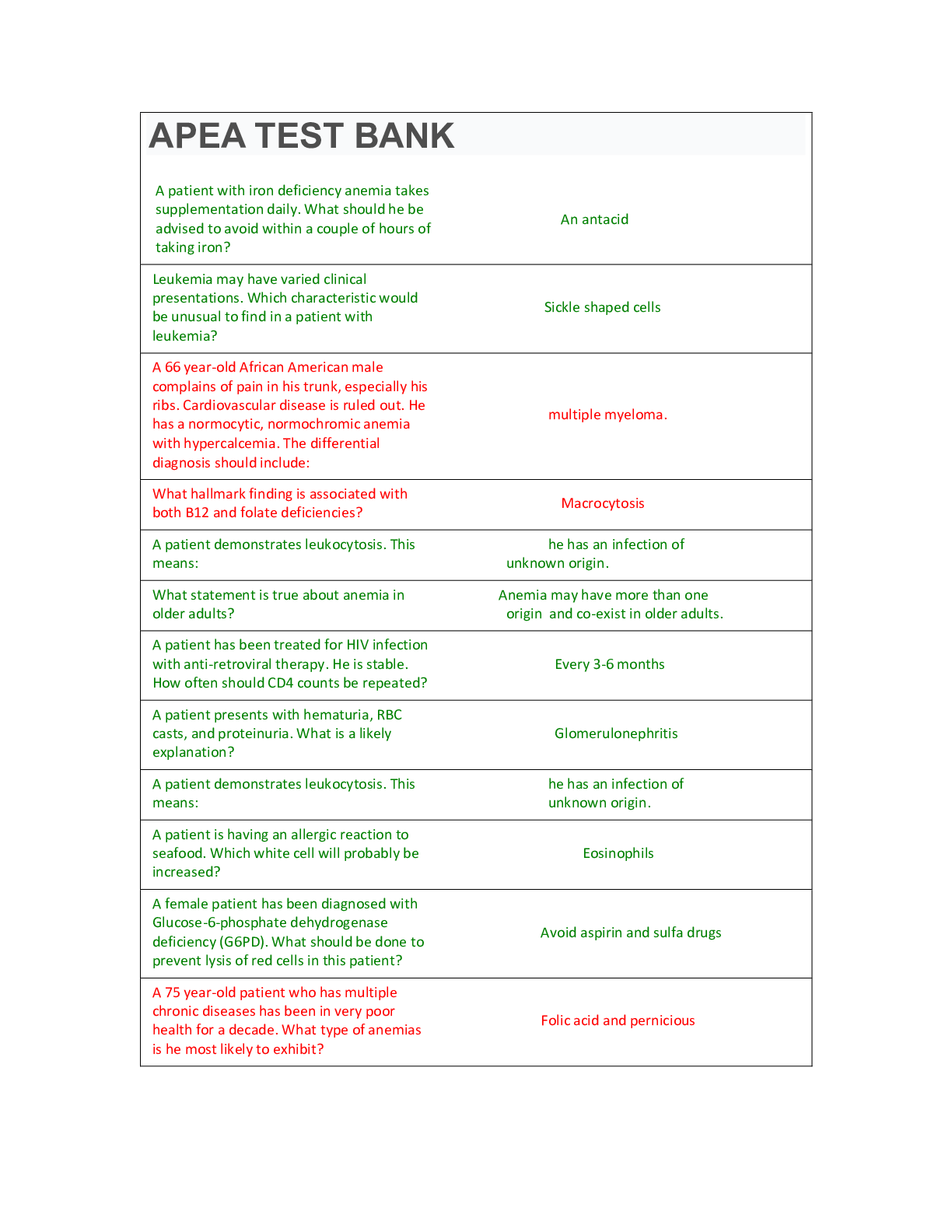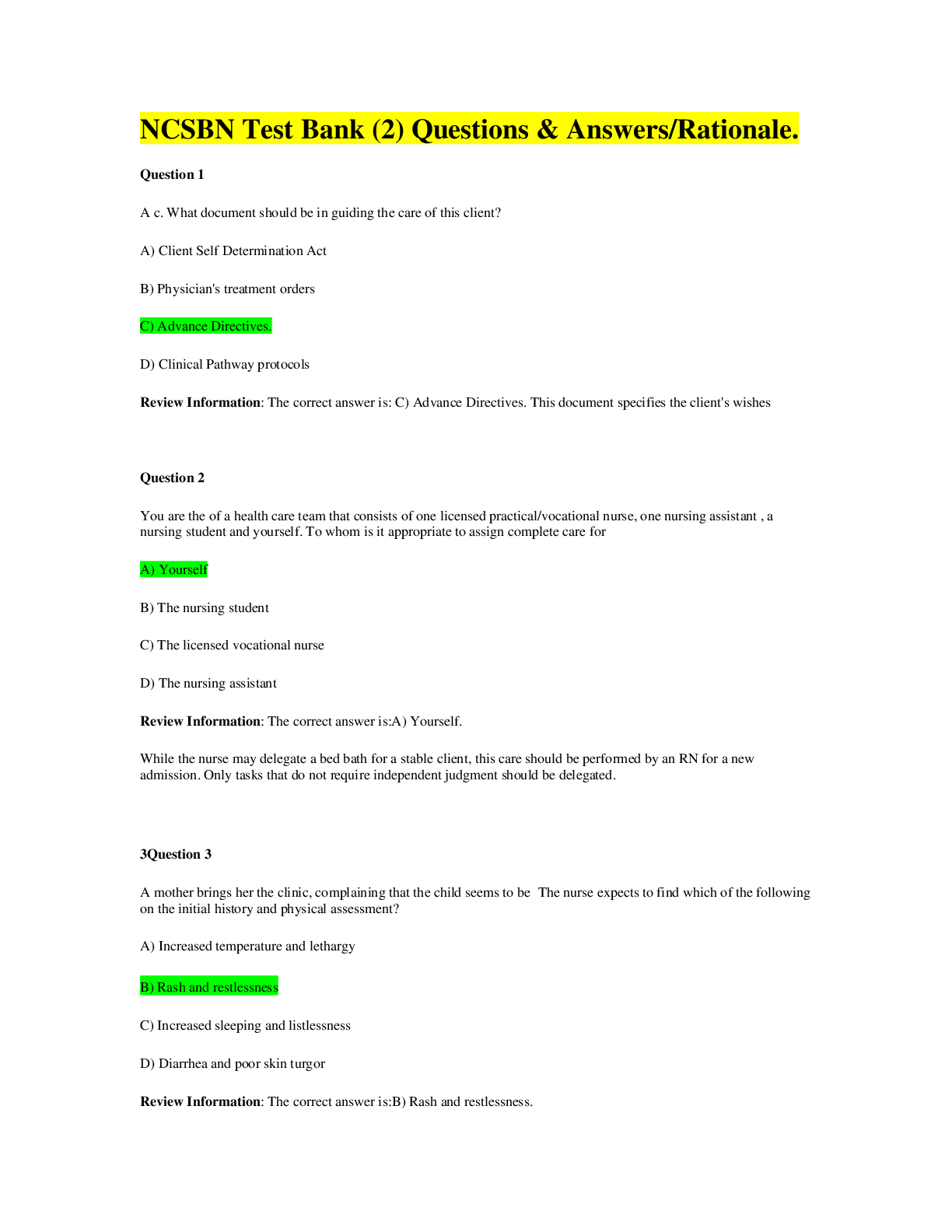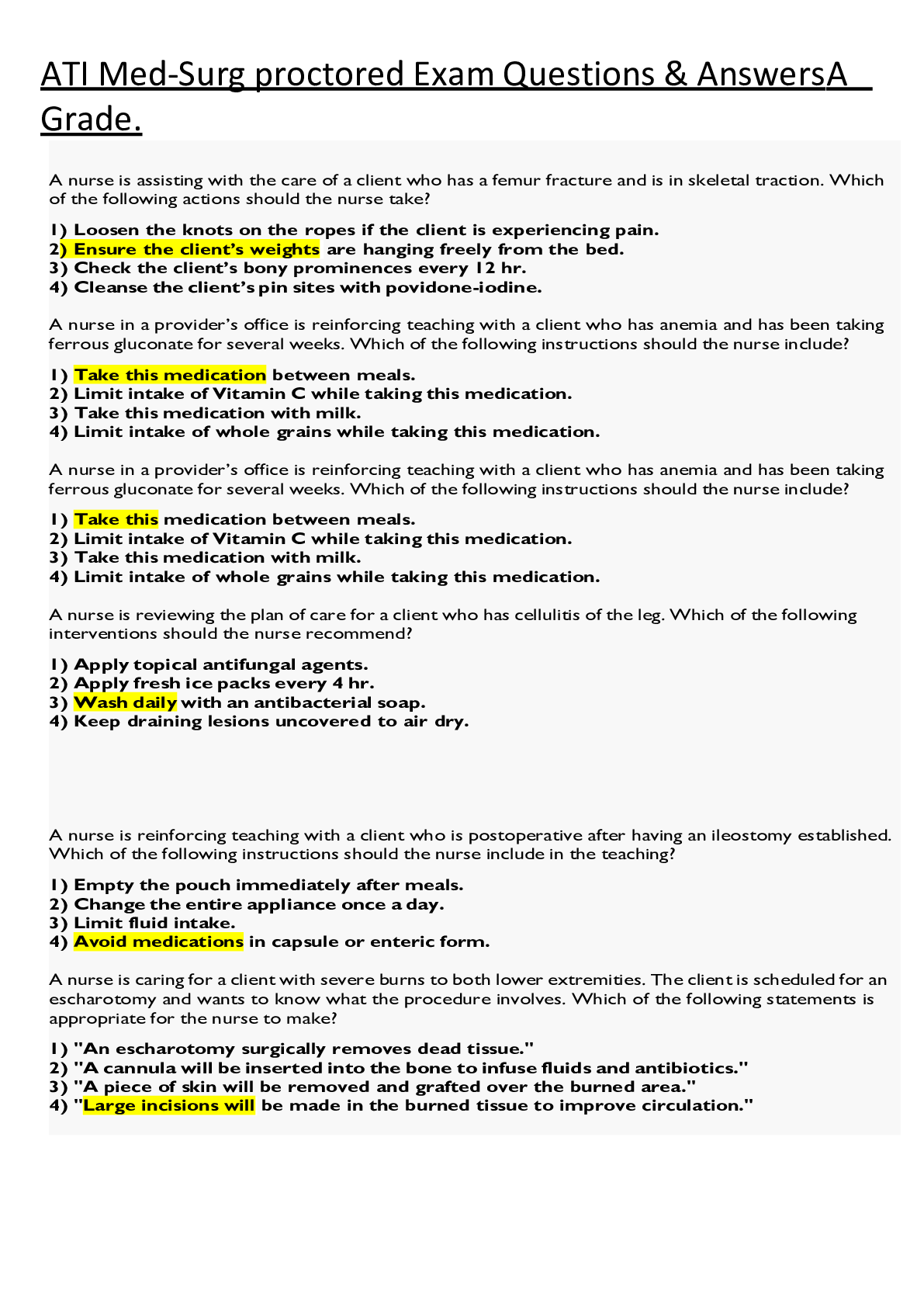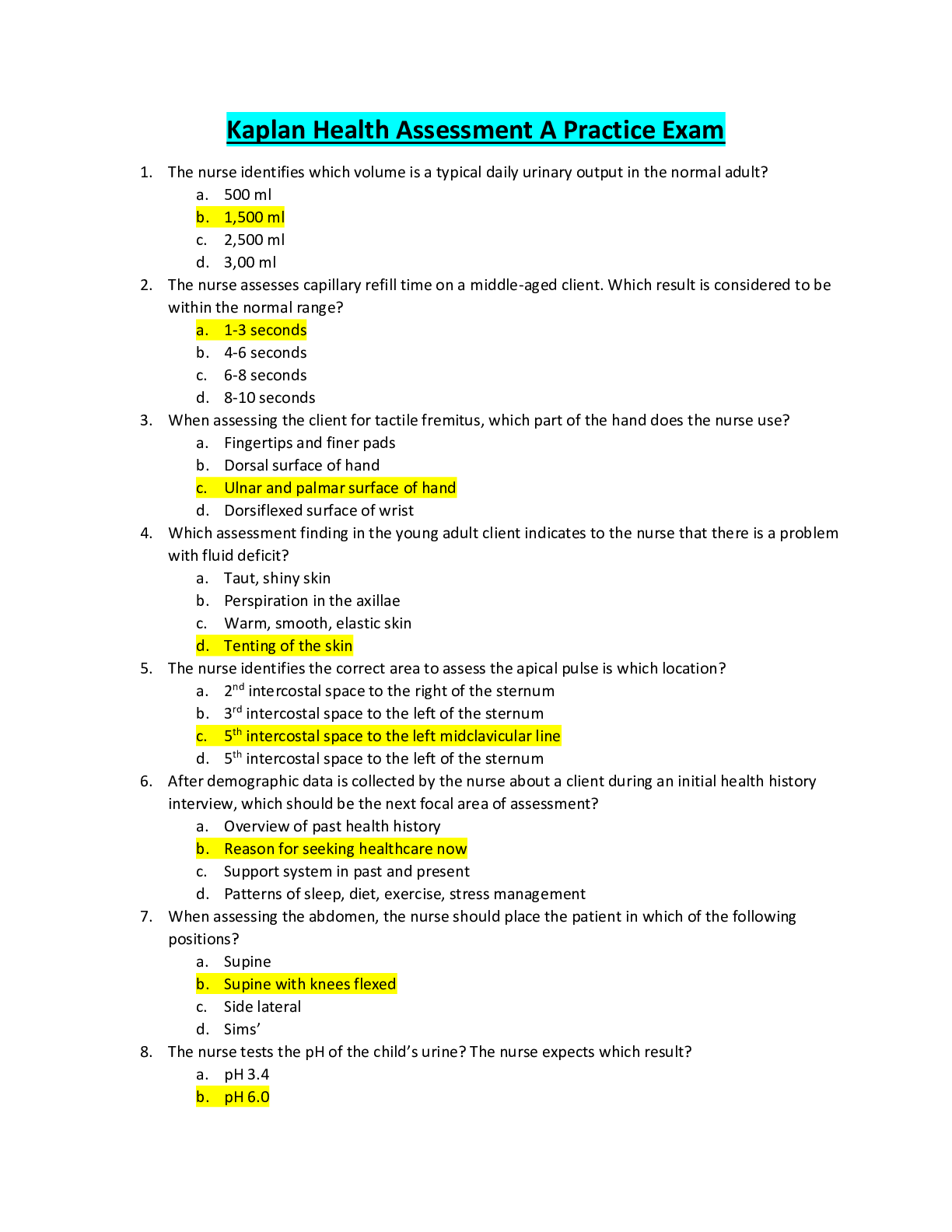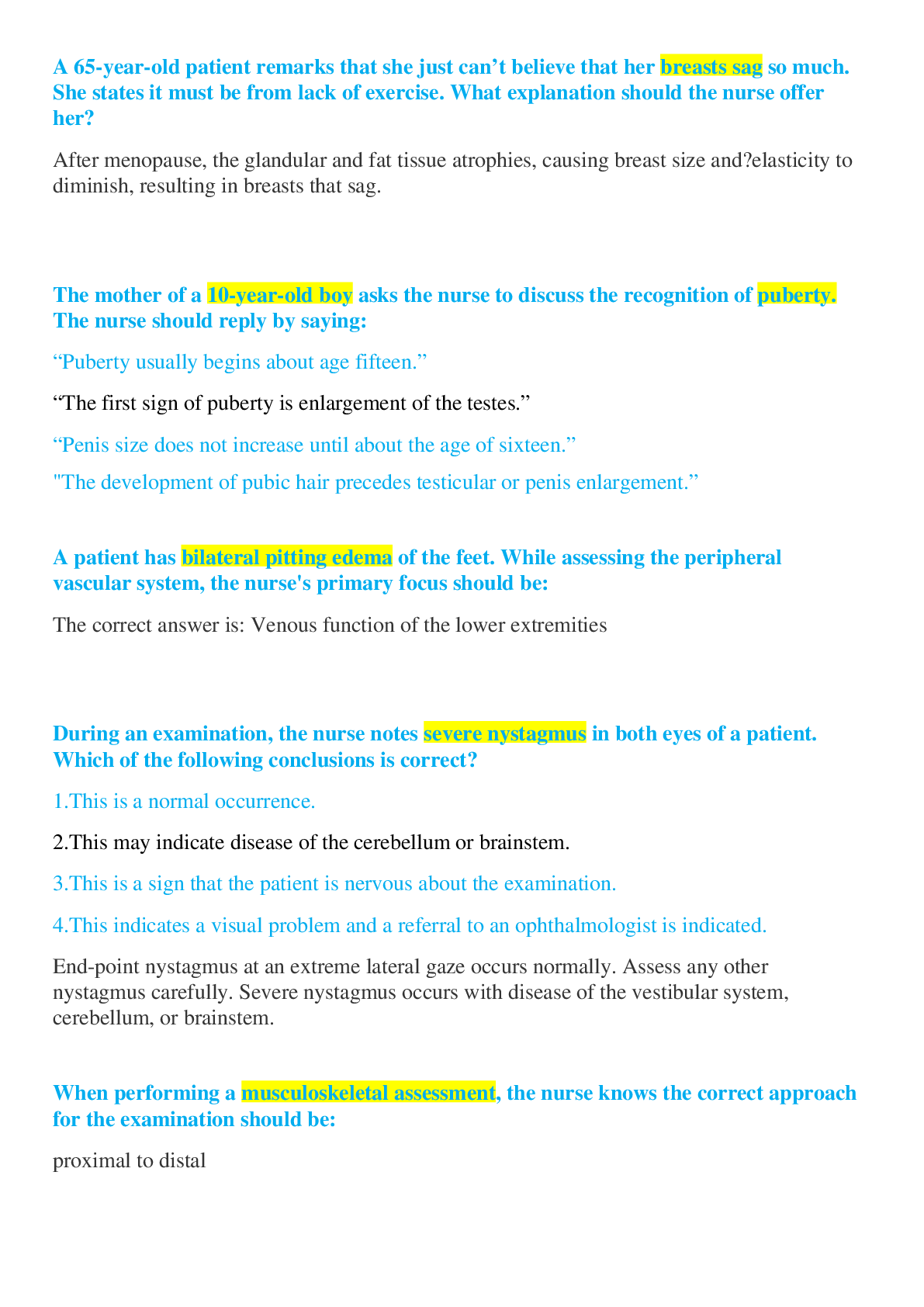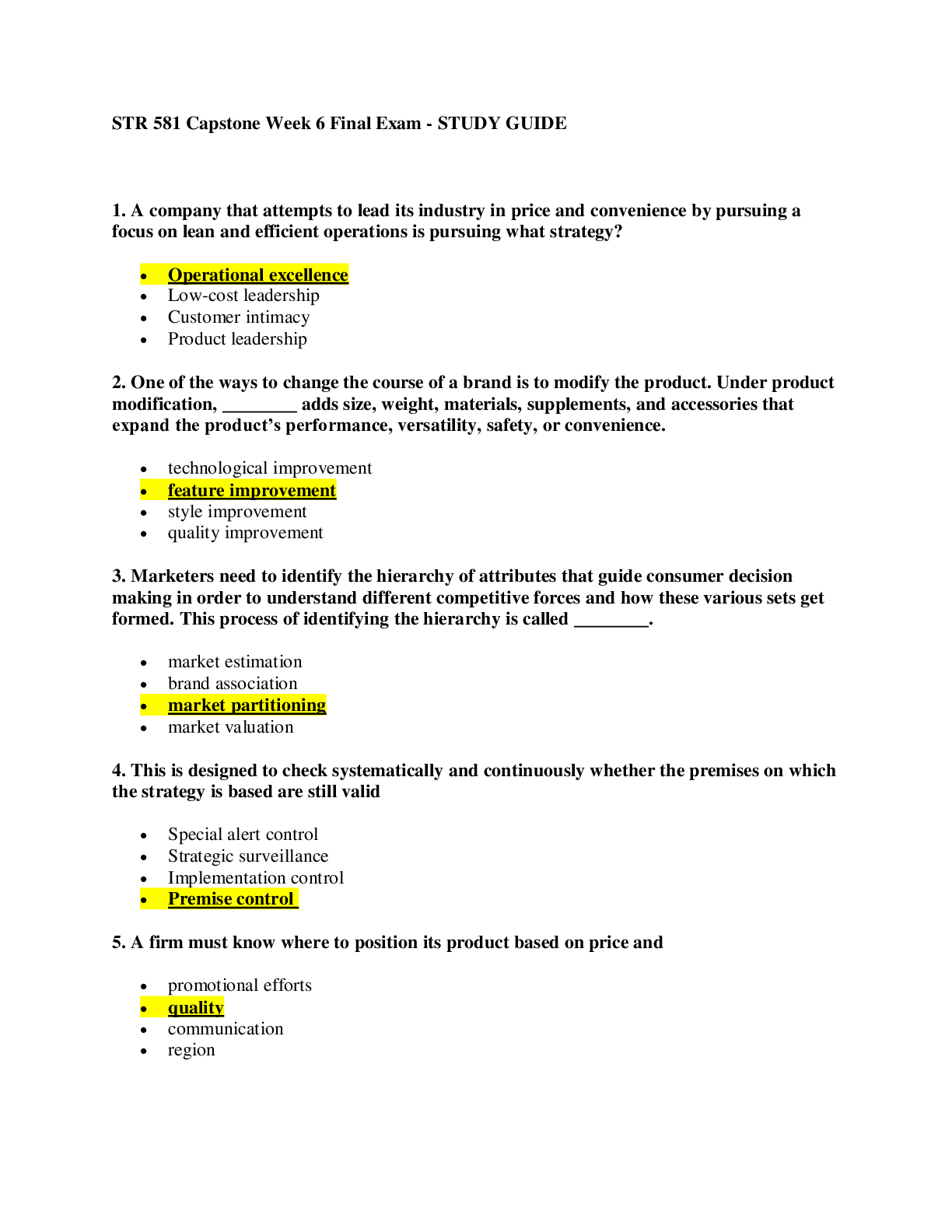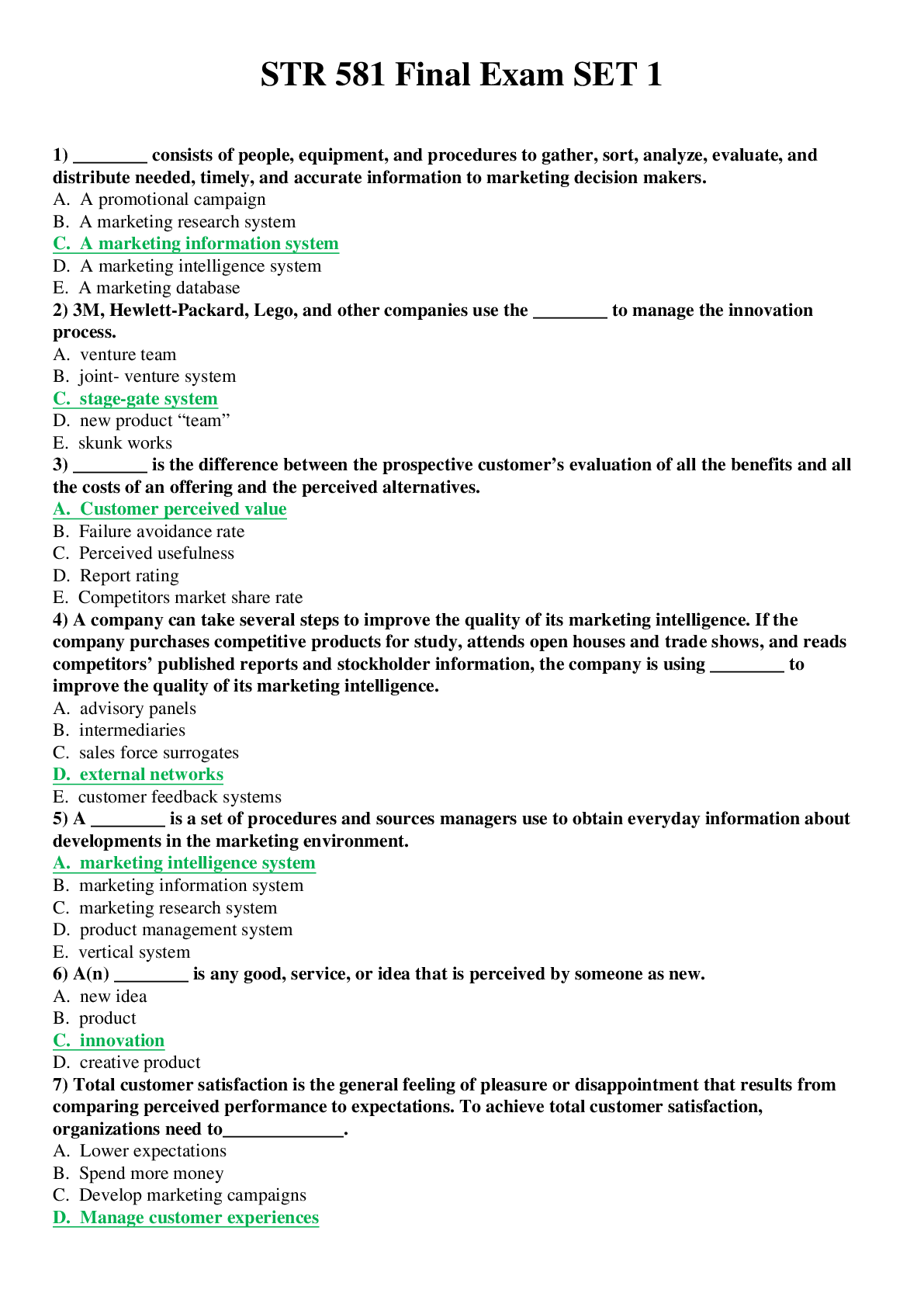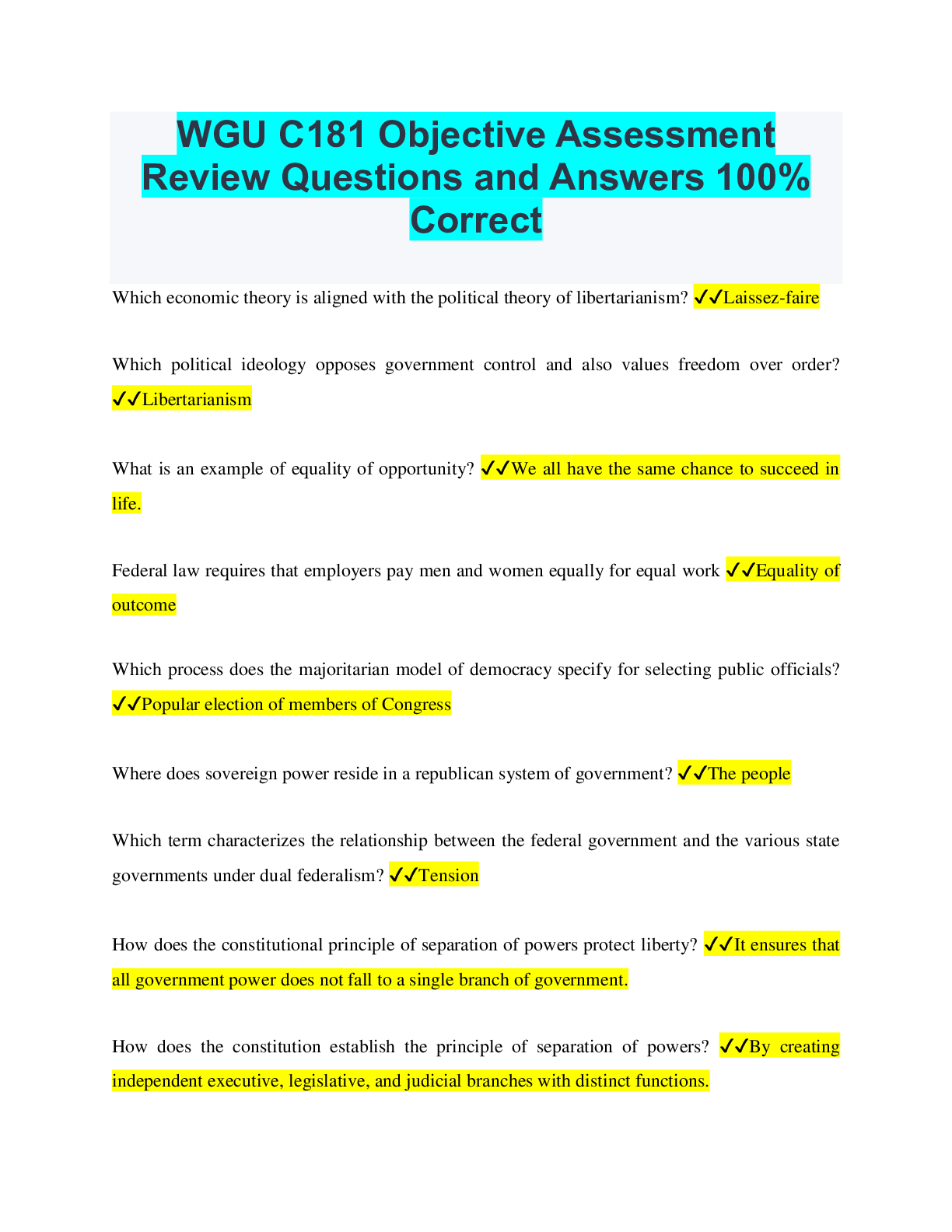*NURSING > QUESTIONS & ANSWERS > NURSING PN 161 Question from Study Guide, All answers 100% correct, Rasmussen. (All)
NURSING PN 161 Question from Study Guide, All answers 100% correct, Rasmussen.
Document Content and Description Below
NURSING PN 161 Question from Study Guide 1) A patient who came from central America is admitted with diabetes mellitus. The nurse is collecting biographical information. Which information provided by... the patient represents his ethinicity:; a) Latino b)Catholic c)White d) Teacher 2) When the body produces an excess amount of insulin, the nurse should monitor for signs and symptoms of: a)Diabetes insipidus b)Diabetes Mellitus c)Hyperglycemia d)Hypoglycemia 3) Preoperative client teaching should include the purpose of the surgical site skin preparation which is to: a)Lower the number of microorganism on or near operation site b)Prevent wound infection c)Remove soil around the operation site d)Sterilize the skin 4) Therapeutic communication involves which of the following a)Passive listening b)Active listening c)Disregard of Body language d)Conflict Avoidance 5) Which are examples of barrier protection a)Hand cream b)Negative pressure rooms c)Gloves, gowns, and mask d)Wound dressing 6) The major goal of medical nutrition therapy for clients with diabetes mellitus is to a) Reduce serum lipid levels b) Improve health through optimal nutrition c) Maintain as near normal glucose level as possible d) Wean insulin dependent client with diabetes from insulin diet control 7) Which aspect of restrain use can the nurse delegate to the nursing assistive personell a) Assessing the patient status b) Determining the need for restrain c) Evaluating the patients response to restraint d) Applying and removing the restrain 9) Nursing intervention for clients with intestinal obstruction include all of the following. Which action would be a priority. a) Administering IV fluids and electrolytes as ordered b) Checking weight daily c) Giving oral care frequently d) Monitoring intake and output every shift 10) Which of these data provide the most information about the pain the client is experiencing a) Objective changes in vital signs such as increased respiratory rate, heart rate and blood pressure b) The amount of tissue damage actually occurring or already present c) Facial expression and level of mobility d) When is a health care worker at greatest risk of being exposed to tuberculosis e) Self-report 11) A client of who have severe and prolonged osteoporosis may experience loss of a) Height b) Joint function c) Muscle mass d) Weight 12) Which body fluids lies in the space between the body cells a) Interstitial b) Intracellular c) Intravascular d) Transcellular 13) QSEN competencies are based on developing which of the following a) Understanding sympathy and caring b) Knowledge ,communication and caring c) Nursing care safety and empathy d) Knowledge skills ATTITUDE 14) Client with diverticulus will frequently complain of abdominal pain located in which area of the abdomen a) Generalized b) Left lower side c) Right lower side d) Umbilicus area 15) As diseases progress symptoms of imuneno deficiency virus(HIV) become evident when which of the cells of the immune system decrease a) B cells b) Macrophages c) Neutrophils d) CD4T cells 16) The process by which substances can pass through the cell membrane without energy expenditure on the part of cell is called a) Active transport b) Passive transport c) Permeability d) Dialysis 17) Which individual can help a client prepare for the adjustment to life with a fecal diversion a) Client personal physician b) Skin care nurse c) Wound, ostomy, and continence nurse d) Fecal diversion nurse 18) In caring for a client who is taking oral hypoglycemic agent, the nurse recognize these medications are used in the treatments of which type of diabetes a) Gestational, requiring therapy for a very short time b) Type 1 non stable with insulin administration only c) Type2, not controlled with diet and exercise d) Type 1 and type2, not controlled with diet and exercise 19) A client incorporates alternative health care into her regular health practice. For which alternative therapy should a patient visit a formerly trained practitioner. a) Use of herbs and roots b) Application of oil and poultices c) Burning of dried plants d) Acupuncture 20) Identify the mechanism involved in Acid base balance a) Respiratory mechanism b) A,C and D are Correct c) Renal mechanism d) Buffer systems 21) Which process requires energy to maintain unique composition of extracellular and intracellular compartments a) Diffusion b) Osmoisis c) Filtration d) Active transport 22) What is the advantage of giving Metformin a bigunide to a client requiring oral hypoglycemic agent a) It can be administered on a more flexible schedule b) It does not have the major side effects of nausea, abdominal discomfort and diarrhea c) It does not increase insulin release or produce hypoglycemic episodes d) It does not tend to reach with other medications. 23) Client with which type of colostomy may have the option of daily irrigation a) Ascending b) Descending c) Transverse d) Double barrel 24) In which situation would a client require glucose management by sliding scale insulin. a) Client with type 1 diabetes mellitus, experiencing stress, illness or surgery b) Client with type 1 or type 2 diabetes mellitus experiencing illness, stress or surgery c) Client newly diagnosed with type 2 diabetes mellitus d) Client participating in rigorious sport or activities 25) Identify the appropriate intervention for a patient with hypovolemia a) Teach deep breathing techniques b) Monitor I&O daily c) Encourage fluid intake d) Monitor electrolyte balance e) B,C and D are correct 26) Surgical client who have chronic respiratory diseases are most likely to develop which postoperative complications a) Atelectasis b) Stroke c) Hypovolemic shock d) Myocardial infraction 27) According to the joint commission which of these situations about pain and its management are true a) Clients are assumed to experience some degree of pain at all time b) Staff must take special courses to be competent in pain management c) Pain assessments is considered to be the fifth vital sign d) There must be evidence that the least expensive, most effective pain medication are used 28) Client who have diabetes mellitus are prone to what postoperative complication a) Atlectasis b) Hemorrhage c) Infection d) Pressure sores 29) Postoperative teaching should include how to perform postoperative leg exercises, which are done to prevent which complication of surgery a) Ankylosis of the joint b) Atrophy of the muscles c) Thrombosis formation d) Pneumonia 30) The nurse is caring for a patient experiencing postoperative pain, which of the following will affect the client pain level a) Culture b) Type of housing c) Age d) Previous experience e) A,C and D 31) Which of these substances is required for calcium absorption within the GI tract a) Albumin b) Glucose c) Triglycerides d) Vitamin D 32) What is the most common chronic complication of diabetes mellitus a) Blindness b) Renal failure c) Morbid obesity d) Neuropathy 33) Identify which of these elements determines the PH range within the body internal environment a) Bicarbonate b) Carbon dioxide c) Hydrogen d) Oxygen 34) Which routes of pain medication administration provides the most rapid onset of pain relief a) Intramuscular b) Intravenous c) Oral d) Transdermal 35) The largest population at risk for osteoporosis is a) African American women under age 65 b) Caucasian women over 65 c) Hispanic women under 65 d) African American women over 65 36) A nurse observe that a client ileal conduit stoma is dark bluish in the immediate postoperative period which action should the nurse take. a) Chart the observation b) Have the client assume a semi fowler position c) Remove the pouch and make the pouch opening larger d) Notify the surgeon immediately 37) The nurse is caring for a client with human immune deficiency virus (HIV) understand that the client is considered to have immune deficiency syndrome(AIDS) When which of the following occur a) Appearance of flulike symptoms b) CD4T cells count of less than 200 cells/mm and one defined client condition c) Enlarged lymph nodes for more that 3 months d) One positive enzyme linked immunosorbent assay(ELISA) test 38) When a solution has a PH of less that 7. What is it classification a) Acid b) Base c) Neutral d) Buffer 39) Which is the most commonly reported incident in the hospital a) Equiptment malfunction b) Patient falls c) Laboratory specimen errors d) Treatment delays 40) The nurse assess that the patient intravenous solution has infiltrated into the tissues. What action should she take first a) Aspirate , then inject 0.5 normal saline b) Restart the IV in different vein c) Stop the infusion immediately d) Notify the primary care provider 41) Which of these statements about CHRONS diseases is true a) It affects only the mucosal lining of the bowel b) It is treated by colostomy c) It can occur anywhere in the small and large intestine d) It can produce 15 to 20 liquid stool containing blood daily 42) The joint commission focuses on safety in health care. which action by the nurse reflects the joint commission main objective a) Performing range of motion exercises on the client three times each day b) Ensuring that the client is eating 100% of the meal served to him or her c) Assessing the client respiration when administering opiods d) Delegating to the nursing assistant to give the client a complete bath daily 43) When mixing two different types of insulin in the same syringe, which type is always drawn up first a) Lente , intermediate acting b) NPH intermediate acting c) Regular short acting d) Lantus , long acting 44) Which client is a candidate for fecal diversion a) Client who uses frequent colon cleansing b) Client with chronic constipation c) Client with sesere abdominal pain d) Client with severe ulcerative colitis 45) Which of these organs plays the major role in maintaining the bodys fluid and electrolyte balance a) Kidneys b) Colon c) Lung d) Skin 46) Which of the following is the principle site for regulation of fluid and electrolyte balance a) The heart b) The vascular system c) The pulmonary system d) The kidneys 47) When caring for a client with diagnoses of human immune deficiency virus(HIV) the nurse understands that HIV is transmitted by a) Airborne droplets b) Exchange of body fluids c) Exposure to infected animals or their waste products d) Sexual activity only 48) The nurse is caring for a client experiencing respiratory alkalosis. Which of theses conditions is a causative agent a) Pneumonia b) Brain injury c) Anxiety d) Emphysema 49) Which term refers to the condition in which a person has a potassium level below 3.5mEq/L a) Hyperkalemia b) Hypernatremia c) Hypokalemia d) Hyponatremia 50) Slow progressive degeneration of joint articular cartilage results in which conditions a) Bursitis b) Lyme diseases c) Osteoarthritis d) Rheumatoid arthritis 51) Potassium is mainly excreted by which of these organs a) Kidneys b) Liver c) Respiratory system d) Skin 52) When meeting with a client to make health related decisions , the nurse should a) Assemble the whole family to assist the client b) Allow only one other individual to assist the client c) Meet with the client alone d) Determine with the client who they wish to be involve 53) The joint commission nation speaks up campaign encourage patients to become active and informed participants on the health care team. The goal is to a) Prevent health care errors b) Help control the cost of healthcare c) Reduce the number of automobile accidents d) Provide a forum for people with no health insurance 54) A client has just undergone ileostomy. The semi liquid intestinal content that will continually flow from ileostomy is called a) Influent b) Outfluent c) Effluent d) Esfluent 55) Which of the following is the most common major challenge for older adults a) Dealing with the needs of their children b) Chronic health problems leading to loss of independence c) Loss of the ability to reminisce about the past d) The decline of intellectual abilities 56) A nurse who is able to imagine one self in circumstances similar to what a client is experiencing is able to convey which feeling a) Empathy b) Sympathy c) Trust d) Discernment 57) The focus of nursing activities in the preoperative phase is to a) Admit the patient to the surgical suite b) Prepare the patient mentally and physically for surgery c) Set up the sterile field in the operating room d) Perform the primary surgical scrub to the surgical site. 58) What is very important to note on a client new stoma in the immediate postoperative period a) Blood b) Color c) Shape d) Size 59) Clients who have nutritional deficiency before surgery, are more prone to have which of the following postoperative complication a) Atelectasis b) Delayed wound healing c) Renal failure d) Hepatitis B 60) Which is the most common fracture due to osteoporosis a) Hip 61) A client leaves alone, he is very weak, stays in bed most of the time, and become fatigue after taking only two or three steps with a walker. His personal hygiene is poor, he moves very slowly when doing small tasks such as eating a meal. Which of the following are appropriate interventions for the patient. a) Arrange for home aide to assist with activities of daily living b) Refer the client to a service center for an adopted physical activity program c) Assess the patient for symptoms of depression and memory loss d) Assess the client intake of food, fluids and the nutritional contents of his meals e) All of the above 62) In providing pain medication for the postoperative client , what is the preferred route of administration when the client is NPO a) Epidural b) Intramuscular c) Intravenous d) Oral 63) The nurse is caring for a client who has a family history of diabetes, is obese and is aging. which type of diabetes would the nurse suspects this client has a) Gestational diabetes mellitus b) Immune-mediated diabetes mellitus c) Type 1 diabetes mellitus d) Type 2 diabetes mellitus 64) Which of these terms refers to the maintenance of the body’s internal environment within narrow limits a) Homeostasis b) Osmosis c) Diffusion d) Elimination 65) The nurse has a prescription to give a series of medication as “on call” the nurse knows that these medication should be given d)When the OR staff notify the nurse to do so 66) Which of these body system regulate Acid base balance within the body a) Central nervous system and lymphatic system b) Heart and lungs c) Integumentary system and lungs d) Lungs and kidneys 67) When is a health care worker at greatest risk of being exposed to tuberculosis a) During and after procedures that induce coughing in clients with TB b) When handling products of a client with HIV c) When caring for client at risk for developing TB, such as client who are HIV positive d) When caring for clients who have come to the united states from other countries 68) Which of these process is an example of passive transport a) Diffusion b) Buffering c) Integration d) Configuration 69) A client who has diabetes mellitus is scheduled for surgery tomorrow. Which of the following accommodation will be made a) The dose of the insulin for the morning of the surgery will be reduced b) IV fluids will be omitted c) Surgery will be scheduled as early in the morning as possible d) Serum glucose will be carefully monitored immediately after surgery 70) A client who has enlarged prostate gland tells the nurse he feels his bladder is not empty after voiding and his health care provider request a check for residual urine. Which of these nursing actions is correct? a) Catheterize him immediately after he voids, and record the amount obtained b) Have him measure his voiding’s in sequentially numbered containers and record the amount of time for each voiding c) Insert a retention catheter, and collect it to a bed side collection unit. d) Keep an accurate intake and output(I&O) and subtract and record the difference between the intake and output for each 8 hour shift. 71) Which of these statements about chronic pain is true a) Is accompanied by elevated heart rate, respiratory rate, and blood pressure b) It persist for six months or longer C ) it is usually described as sharp, but it is difficult to pinpoint c) It signs and symptoms are similar to depression 72) A client blood PH is 7.5. the nurse should recognize that this is considered to be a) Critically decreased, in need of immediate intervention. b) Decreased c) Normal d) Increased 73) A client with urinary retention may be treated by all of the following methods. Which method is preferred when the client is in acute distress a) Antispasmodic b) Surgery c) Urinary analgesics d) Urinary catheterization 74) The movements of substances across cell membranes, using chemical energy and carrier molecule is called a) Active transport b) Diffusion c) Filtration d) Osmosis 75) The nurse is caring for a client with diagnosis of pneumonia. The client aterial blood gas results indicate a PH of7.32 and a Paco2 of 52mmHg. The nurse determines that these results indicates which of the following results a) Metabolic acidosis b) Metabolic alkalosis c) Respiratory alkalosis d) Respiratory acidosis 76) The nurse is caring for a client experiencing diabetic ketoacidosis and notes that the client is exhibiting kassumal respirations. Based on this information which of the following would the nurse most likely observe. a) Respirations that are abnormally deep, regular and increased in rate b) Respirations that are regular but abnormally slow c) Respirations that are labored and increased in depth and rate d) Respirations that cease for several seconds 77) A nurse is caring for a patient who emigrated from peutarico. She can best care for this patient by learning about the a) Practices of the patient ethnic group b) Patient’s individual cultural beliefs c) Values of her own culture d) Spanish speaking community 78) A client is taking a medication that includes digoxin, baby aspirin and Lasix. The client complains of muscle cramps and facial tics. The nurse discovers the patient have positive Chvostek and Trosseu signs, has hypertension and is confused. If the client is exhibiting signs of hypomagnesemia, which of these findings would the nurse also expect the client to exhibit. a) Elevate serum calcium and potassium levels b) Decreased serum calcium and potassium levels c) Impaired acid base balance d) Bradycardia and cardiac dysrhythmias 79) A set of universal expectation to support and enhance all aspect of patient care is a) Universal precaution b) Universal safety goal c) National patient safety goal d) Patient satisfaction goal 80) Which of the following may occur as a side effect of administering opiates a) Anxiety b) Diarrhea c) Palpitation d) Respiratory depression 81) Increased sodium intake, decreased sodium loss, or excessive water loss can lead to which of these disturbances a) Hypanatremia b) Hyponatremia c) Metabolic acidosis d) Respiratory alkalosis 82) What is the single most practice in preventing the spread of infection a) Respiratory precaution b) Hand hygiene c) Using aseptic technique d) Using bleach to break chain of infection 83) Which of these terms refers to electrically charged ions present in both intracellular and extracellular fluids a) Electrolytes b) Molecules c) Particles d) Solutes 84) What is the primary function of insulin a) To facilitate active transport of glucose across cell membranes for use by cells b) To convert glycogen to glucose for use c) To stimulate breakdown of adipose tissue d) To increase breakdown of protein into amino acids 85) Physiological changes associated with angle place the older adult especially at risk for which nursing diagnoses a) Risk for falls b) Risk for ineffective airway clearance(chocking) c) Risk for poisoning d) Risk for suffocation(drowning) 86) Who is the most consistent health team member involved in client pain management a) Anesthesiologist b) Nurse c) Pharmacist d) Physician 87) What is the most common reason a colostomy is performed a) Ruptured diverticulum b) Traumatic injury to colon c) Colorectal cancer d) Ischemic bowel syndrome 88) The nurse know that if a client is retaining too much hydrogen or loosing too much bicarbonate. It can result in which of these conditions a) Metabolic acidosis b) Metabolic alkalosis c) Respiratory acidosis d) Respiratory alkalosis 89) Which electrolyte is the primary regulator of fluid volume a) Potassium b) Calcium c) Sodium d) Magnesium 90) What are the early warning signs of bladder cancer a) Dysuria and urgency b) Gradual onset oliguria and proteinuria c) Increased urinary frequency and painless, intermittent hematuria d) Sudden onset anuria after cystitis 91) Identify which of this process is used by sodium to control body fluids balance a) Active transport b) Diffusion c) Filtration d) Osmosis 92) A client who has ulcerative colitis, has an increased chance of developing which of the following a) Viral pneumonia b) Colorectal cancer c) Pernicious anemia d) Intestinal obstruction 93) What is the cornerstone of treatment for the person who has type 2 diabetes a) Blood glucose monitoring b) Medications with oral hypoglycemic agents c) Nutritional therapy and exercise initially d) Weight loss 94) Verbal communication is extremely in caring for clients. listening to clients is just as important . which of the following are keys to effective listening a) Giving full attention b) Avoiding interruptions c) Providing premature interpretations d) Summarizing what client has said e) A,B and D only 95) Which of the following is the most appropriate goal for a client with the nursing diagnoses of deficient fluid volume a) Electrolyte balance restored, as evidenced by improved levels of alertness and cognitive orientation b) Electrolyte balance restored, as evidenced by sodium returning to normal range c) Patient demonstration effective coughing and deep breathing techniques d) Maintains fluid balance as evidence by moist mucous membranes and urinating every 4 hours. 96) The nurse is caring for a client experiencing metabolic acidosis. Which of these conditions may cause this. a) Overly vigorous mechanical ventilation b) Hyperkalemia c) Prolonged nasogastric suctioning d) Pain 97) Which of these post -operative complication is more likely to occur in older adults clients. a) Deep vein thrombosis b) Dehydration c) Pneumonia d) Unpredictable response to medications and anesthetics 98) A client has had blood drawn for determination of serum electrolytes level. The nurse identifies which of the following as abnormal value a) Sodium 149 mEq/L b) Potassium 3.8 mEq/L c) Calcium 9.5 mg/dl d) Bicarbonate 26 mEq/l 99) The nurse is caring for a client with critically high potassium level. The client has received sodium polystyrene sulfonate(kayexalate). The nurse determines the medication effectiveness if the client repeat serum potassium level is a) 6.2 mEq/l b) 5.8 mEq/l c) 5.5 mEq/l d) 4.7 mEq/l 100) [Show More]
Last updated: 2 years ago
Preview 1 out of 13 pages
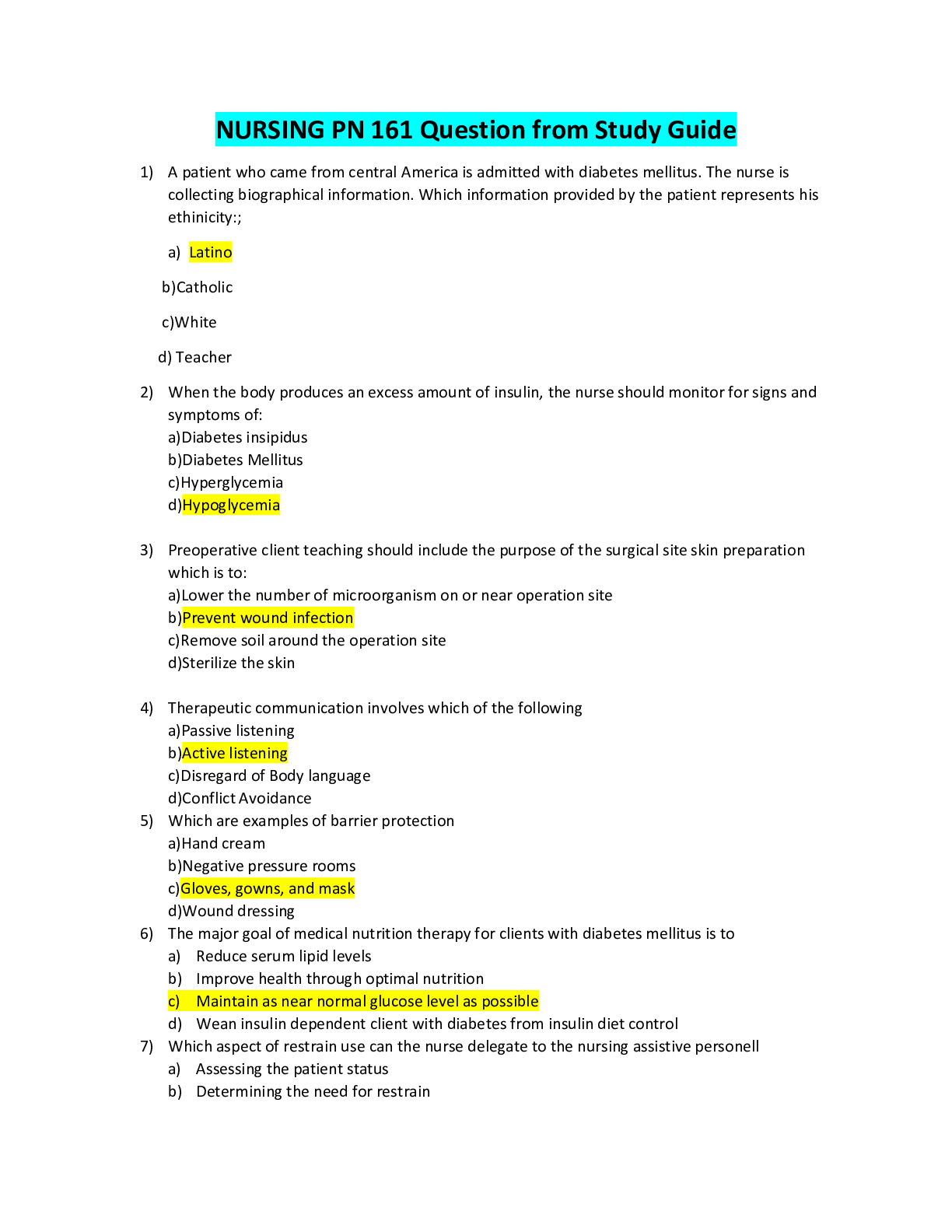
Buy this document to get the full access instantly
Instant Download Access after purchase
Buy NowInstant download
We Accept:

Reviews( 0 )
$15.00
Can't find what you want? Try our AI powered Search
Document information
Connected school, study & course
About the document
Uploaded On
Jul 20, 2020
Number of pages
13
Written in
Additional information
This document has been written for:
Uploaded
Jul 20, 2020
Downloads
0
Views
97

